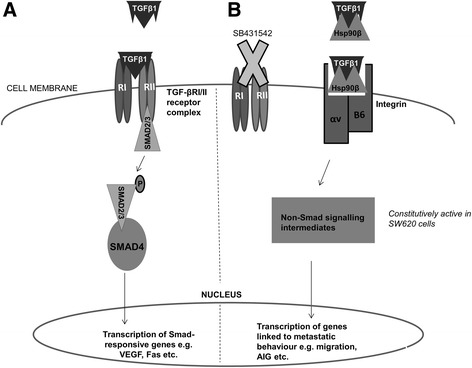Fig. 7.

Model describing the effect of a synergy between extracellular TGF-β1 and Hsp90β on downstream signalling in colon cancer cells. a In the presence of TGF-β1 alone, binding to the heterotetrameric TGF-βRI/II receptor complex triggers phosphorylation of Smad2/3 and subsequent activation of Smad4, whereupon the complex moves into the nucleus and triggers transcription of canonical Smad-responsive genes such as VEGF (tumour promoting) and Fas (tumour suppressing). b In the presence of both TGF-β1 and Hsp90β in the extracellular space, when binding of TGF-β1 to the TGF-βRI/II receptor complex is inhibited using SB431542, TGF-β1 and Hsp90β instead bind to αvβ6 integrin, triggering as yet unknown downstream non-Smad signalling pathways, culminating in the transcription of genes which promote metastatic behaviours including migration and anchorage-independent growth (AIG). This alternate pathway does not require inhibition of TGF-βRI/II and is constitutively active in SW620 cells, which represent a later stage of colon cancer compared to SW480 cells
